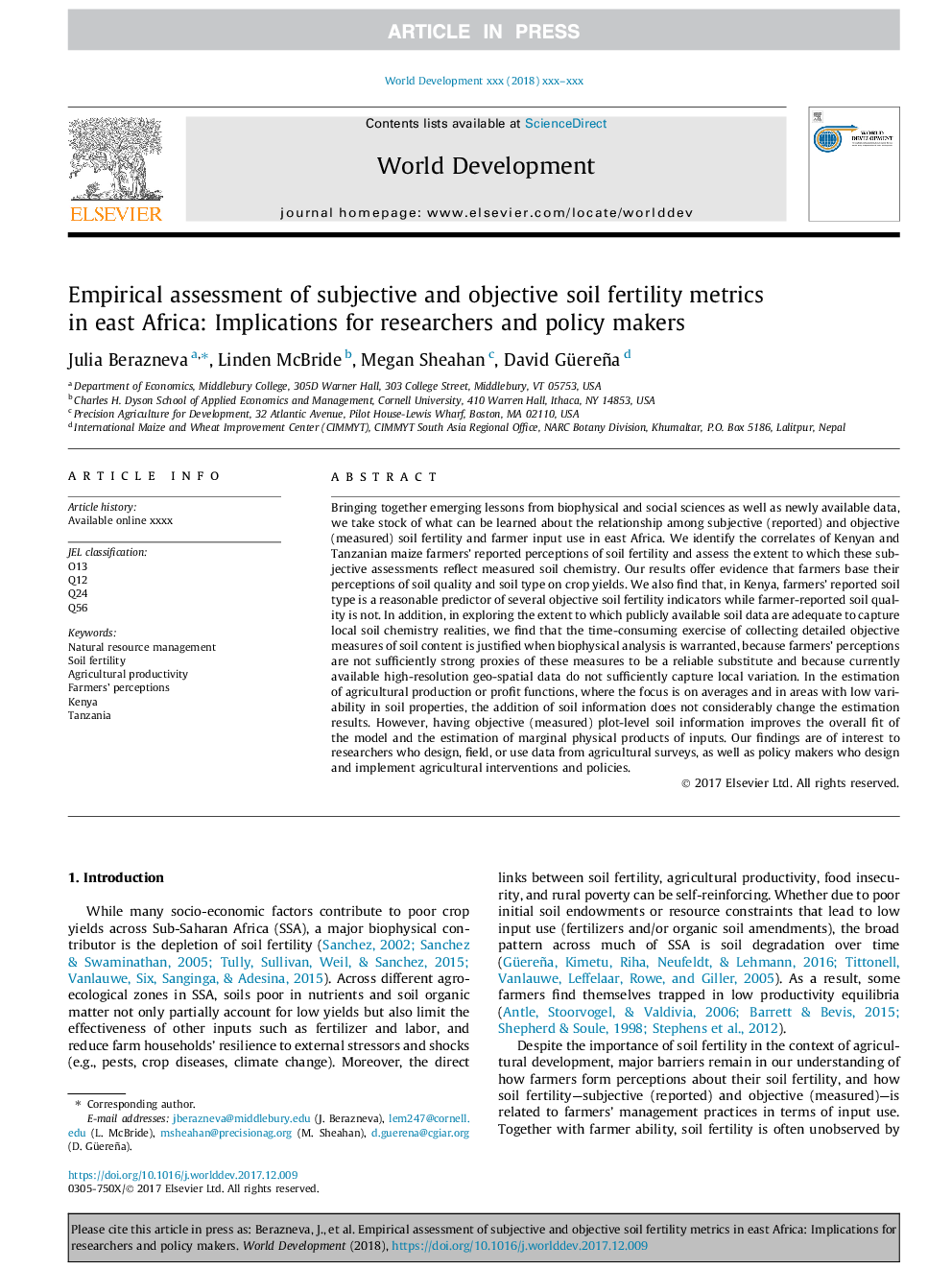| کد مقاله | کد نشریه | سال انتشار | مقاله انگلیسی | نسخه تمام متن |
|---|---|---|---|---|
| 7391982 | 1481113 | 2018 | 16 صفحه PDF | دانلود رایگان |
عنوان انگلیسی مقاله ISI
Empirical assessment of subjective and objective soil fertility metrics in east Africa: Implications for researchers and policy makers
ترجمه فارسی عنوان
ارزیابی تجربی از معیارهای باروری ذاتی و هدفمند در شرق آفریقا: پیامدهای پژوهشگران و سیاست گذاران
دانلود مقاله + سفارش ترجمه
دانلود مقاله ISI انگلیسی
رایگان برای ایرانیان
کلمات کلیدی
ترجمه چکیده
جمع آوری درس های در حال ظهور از علوم بیوفیزیک و علوم اجتماعی و همچنین داده های جدید در دسترس، ما را در مورد آنچه که می توان در مورد رابطه بین باروری خاک (گزارش شده) و هدف (اندازه گیری شده) و استفاده از کشاورزان در شرق آفریقا آموخت. ما همبستگی های ادراک گزارش شده از کشاورزان ذرت زیتون و تانزانیا را در خصوص باروری خاک شناسایی می کنیم و ارزیابی میزان این ارزیابی های ذهنی را نشان می دهد که مواد شیمیایی خاک را اندازه گیری می کند. نتایج ما شواهد نشان می دهد که کشاورزان ادراک خود را از کیفیت خاک و نوع خاک بر تولید محصولات کشاورزی پایه گذاری می کنند. ما همچنین دریافتیم که در کنیا نوع خاک گزارش شده توسط کشاورزان پیش بینی کننده مناسب چندین شاخص شاخص باروری خاک است، در حالی که کیفیت خاک گزارش شده توسط کشاورزان نیست. علاوه بر این، در بررسی اینکه میزان داده های موجود در خاک عمومی مناسب برای جذب واقعیات شیمیایی محلی است، ما دریافتیم که زمان مصرف جمع آوری داده های دقیق از محتوی خاک، هنگامی که تجزیه و تحلیل بیوفیزیکی ضروری است، به این دلیل است که ادراک کشاورزان پراکسی های کافی قوی از این اقدامات به عنوان یک جایگزین قابل اعتماد نیستند و به همین دلیل داده های جغرافیایی و فضایی با وضوح بالا در حال حاضر به اندازه کافی تغییرات محلی را ضبط نمی کنند. در ارزیابی عملکرد تولید کشاورزی یا سود، که در آن تمرکز بر روی میانگین ها و در مناطق با تغییرات کم در خواص خاک، اضافه کردن اطلاعات خاک به طور قابل توجهی نتایج نتیجه برآورد را تغییر نمی دهد. با این حال، داشتن اطلاعات دقیق (اندازه گیری شده) سطح اطلاعات خاک سطح مناسب مدل را بهبود می بخشد و تخمین محصولات فیزیکی حاشیه ای ورودی ها را بهبود می بخشد. یافته های ما علاقه مندان به محققانی است که طرح، زمینه و یا استفاده از داده ها از نظرسنجی کشاورزی، و همچنین سیاست گذاران که مداخلات و سیاست های کشاورزی را طراحی و اجرا می کنند.
موضوعات مرتبط
علوم انسانی و اجتماعی
اقتصاد، اقتصادسنجی و امور مالی
اقتصاد و اقتصادسنجی
چکیده انگلیسی
Bringing together emerging lessons from biophysical and social sciences as well as newly available data, we take stock of what can be learned about the relationship among subjective (reported) and objective (measured) soil fertility and farmer input use in east Africa. We identify the correlates of Kenyan and Tanzanian maize farmers' reported perceptions of soil fertility and assess the extent to which these subjective assessments reflect measured soil chemistry. Our results offer evidence that farmers base their perceptions of soil quality and soil type on crop yields. We also find that, in Kenya, farmers' reported soil type is a reasonable predictor of several objective soil fertility indicators while farmer-reported soil quality is not. In addition, in exploring the extent to which publicly available soil data are adequate to capture local soil chemistry realities, we find that the time-consuming exercise of collecting detailed objective measures of soil content is justified when biophysical analysis is warranted, because farmers' perceptions are not sufficiently strong proxies of these measures to be a reliable substitute and because currently available high-resolution geo-spatial data do not sufficiently capture local variation. In the estimation of agricultural production or profit functions, where the focus is on averages and in areas with low variability in soil properties, the addition of soil information does not considerably change the estimation results. However, having objective (measured) plot-level soil information improves the overall fit of the model and the estimation of marginal physical products of inputs. Our findings are of interest to researchers who design, field, or use data from agricultural surveys, as well as policy makers who design and implement agricultural interventions and policies.
ناشر
Database: Elsevier - ScienceDirect (ساینس دایرکت)
Journal: World Development - Volume 105, May 2018, Pages 367-382
Journal: World Development - Volume 105, May 2018, Pages 367-382
نویسندگان
Julia Berazneva, Linden McBride, Megan Sheahan, David Güereña,
